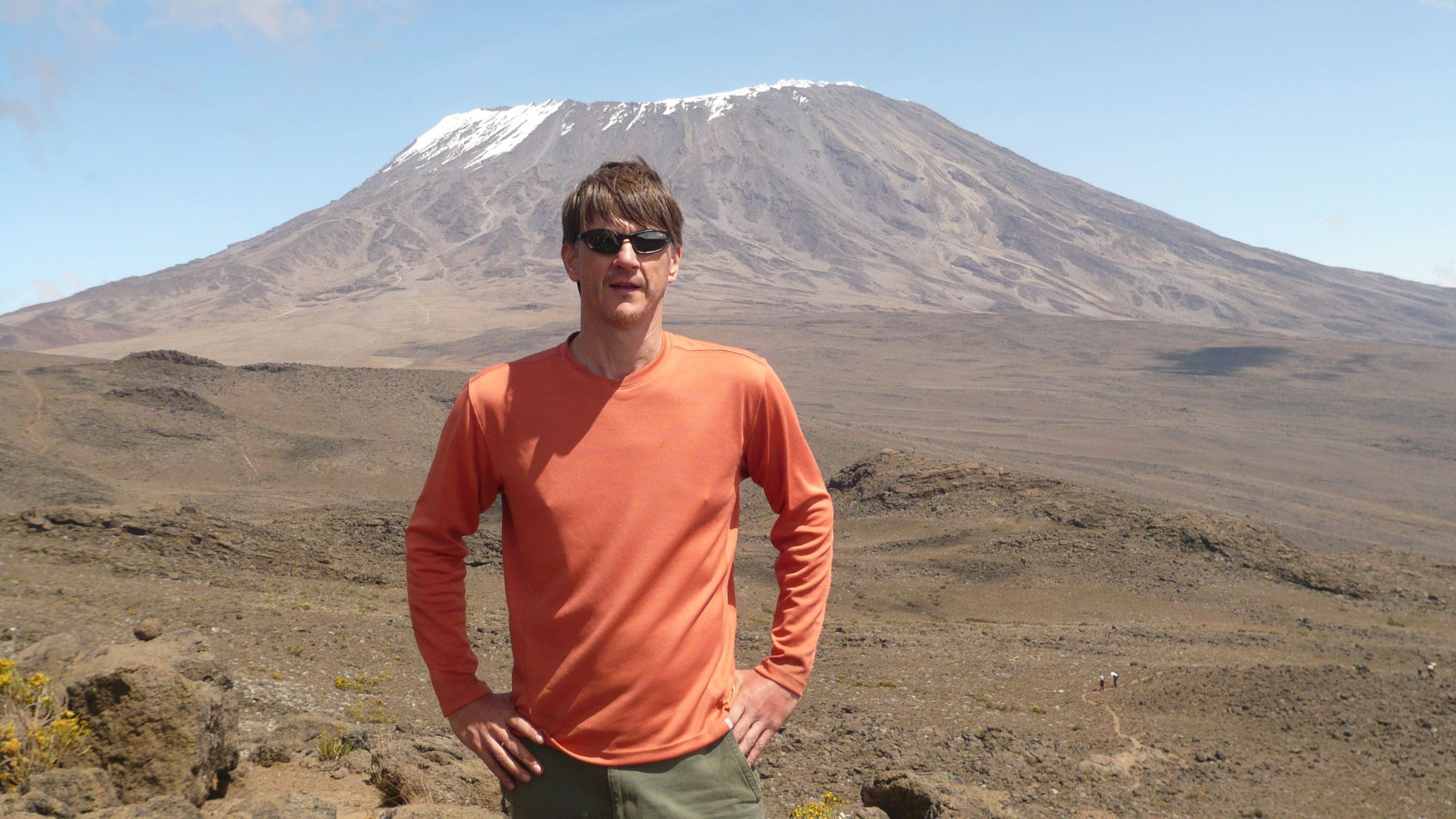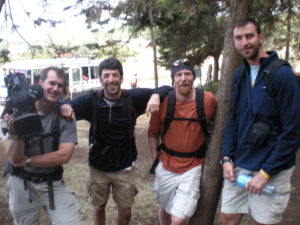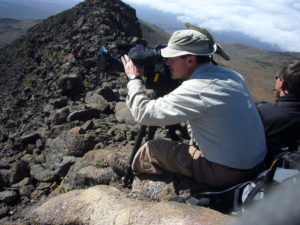VHN+
VHN Puck Adventure, Holiday Special – Zdeno Chara, Pt 1

Happy Holidays Vancouver Canucks fans. Here’s a little bonus for our VHN Plus folks. Actually a big bonus: The full first chapter of the two-part story of climbing Mount Kilimanjaro for charity with then Boston Bruins captain Zdeno Chara. Originally published by ECW Press in my book No Heavy Lifting in 2018, with a foreword by John Shannon.
In memory of Mark Berg, who passed away from cancer in early 2021.
A third of this chapter was shared with the Hockey Wanderlüst newsletter this weekend. VHN’ers get the whole thing here.
“Piece of cake.”
— Comment by a passerby, on our way to climb Mount Kilimanjaro, June 2008
BIG Z ON THE MOUNTAIN, PART 1
In the summer of 2008, Boston Bruins Captain, Zdeno Chara, decided to add his name to the list of NHL hockey players involved with the international humanitarian organization Right To Play. Chara, the tallest player in league history, would do this in a fittingly large manner. Not only would he visit underprivileged African children for a few days in Mozambique with Calgary Flames defenseman Robin Regehr as RTP Athlete Ambassadors, Chara would then stick around and raise awareness for the cause by trekking up Africa’s highest mountain, Kilimanjaro, in Tanzania.
The climb involved four other people.
Mark Brender, Deputy Director of RTP Canada, organized the entire trip and accompanied the hockey players around Mozambique before joining in on the trek. Brender, in a previous life, had traipsed around a portion of the Himalayas.
Darryl Lepik was a producer for NHL Productions/Studios who leapt at the chance to climb Kilimanjaro. A self-described work-out freak, triathlon type, Lepik essentially built the business opportunity to shoot a documentary around the personal opportunity of climbing the mountain. He made the travel and budget arrangements for himself and his camera guy, organized the shoots, and essentially directed the production.
Mark Berg was Lepik’s hand-picked choice as cameraman. Aside from being affable and talented, Berg was considered in decent enough shape to handle the climb, and, more importantly, interested in taking on the challenge. He was also paid handsomely.

I was the last adventurer. I had been to Africa shooting a documentary with Brender and Right To Play the previous summer and was anxious to get involved again. Like Lepik, for whatever reason, I had a profound interest in summiting this mountain. I planned to take part in just the Tanzanian portion of the excursion, promote the cause, and write about it for a handful of media outlets in Boston. For this, I was not paid handsomely. I actually used frequent-flyer mileage to fly round trip to Africa.
At the last minute, I also decided to make this excursion the sixth and final thirty-minute episode of Hockey Odyssey, a pilot TV series, plagued by a limited budget, which aired on the NHL Network.
Berg would be shooting his documentary on high-definition equipment worth tens of thousands of dollars. I’d be shooting on a Panasonic palm-sized camcorder worth about six hundred bucks.
It all seemed like a great idea: Raise some money and publicity for a good cause and throw in some personal adventure and accomplishment for good measure. Well, as Scottish poet Robert Burns best put it, “The best laid schemes o’ mice an’ men/Gang aft agley” (often go awry).
The first problem for the fellas: logistics and bureaucracy in the developing (“third”) world. Despite the fact that they had properly filled out the necessary paperwork in advance, the customs agent they were dealing with upon arrival in Mozambique wasn’t going to cooperate. Unsure whether to pay him a bribe, and afraid of being arrested if they did, the crew decided to hold their wallets. And without his palm being greased, the customs guy decided not to allow the professional equipment into Mozambique at all. Berg and Lepik were forced to shoot some limited video on their own personal camcorder and to take some still photographs, while the HD equipment remained under government sequester. They did get all the gear back as they left the country, but for the first segments of the final product, they’d use their still shots, plus video from the documentary we’d made the previous summer, involving other kids and different hockey players.
Meanwhile, as the first portion of their journey was winding down, I was flying into Nairobi, Kenya, to meet them at the airport. Unfortunately, I arrived fourteen hours ahead of them, and, no, there’s not a hell of a lot to do at the Nairobi airport.
Typically in this scenario anywhere else in the world, I’d hop a cab or train to the nearby metropolis. In this case, it wasn’t such a good idea. Knowing I was going to be in Kenya for just that day and a brief layover on the way home, I didn’t really want to change any money. More importantly, the crime rate in Nairobi was off the charts at this time, and a popular pastime was the kidnapping of foreign tourists.
Thus, I slept on and off in a chair in the “business class” lounge, drank tea intermittently, ate crackers, and occasionally took a lap around the portion of the airport in which I was allowed. Fortunately Wimbledon was in full swing and I watched a lot of tennis on an international sports channel, and some bizarre foreign movies when the channel was changed.
When my four compadres finally turned up, and I met them in preparation to board our evening connection to Kilimanjaro, the crew was speechless with frustration. Lepik and Berg explained the aforementioned TV camera trauma. Berg was particularly stressed out, still concerned that his equipment had almost been permanently seized.
The conversation then turned to Diamox (acetazolamide), the anti-altitude-sickness medication. I explained how I had taken, at the advice of my doctor, four pills in the morning and four in the afternoon each of the last two days in preparation for the climb, and how the stuff made me have to piss like I had razor blades in my bladder.
Brender in turn described how his doctor had told him to take eight in the morning and eight more throughout the day, and that it also made him have to pee like a well-hung racehorse.
Berg then said his doctor told him to take two in the morning, two in the afternoon and two at night, but that he hadn’t taken any yet. I suggested he abstain completely to avoid excruciatingly intense, short-notice urination urges. Little did we know at this point just how much our Diamox-taking strategy would impact the success or failure of the overall endeavour. I decided to start taking one pill each morning and one before bed each night, Berg and Brender chose to take them rarely and randomly, while Chara and Lepik opted to forego the preventative medication altogether. We each took it upon ourselves to decide on the appropriate drug regime, given the inconsistencies in our various prescriptions, and the fact that we didn’t really believe the drug would make a big difference to how we felt on the climb.
Symptoms of altitude sickness can include headache, nausea and dizziness, loss of appetite, fatigue, shortness of breath, general indifference, and disturbed sleep patterns. All of us would eventually experience at least one of these ill effects. The most important key to avoiding these problems, aside from pre-medication, was gradual acclimatization.
We were less than twenty-four hours from beginning our climb, but we still had to jump on a prop’ plane from Nairobi to Kilimanjaro Airport in Tanzania. What seemed like a routine connecting journey became anything but for me.
Upon arrival just beyond the southern slopes of Kili’, I discovered my luggage had been lost. Normally, lost luggage involves a relatively minor inconvenience and eventual door-to-door delivery by the offending airline. In sub-Saharan Africa: not so much. My shit was gone!
A pair of jeans, some flip flops, maybe a couple shirts, some toiletries—on a trip to Aruba, that would have been OK. But in this case, they had lost my big trek backpack and everything in it. The carefully compiled list of items from Worldwide Quest Agency’s pre-trip checklist was gone. Hiking boots, heavy boots, winter coat for 19,000 feet, gloves, winter pants, socks, fleece, long-sleeved layers, boxers, sleeping mat, sleeping bag, retractable hiking pole, small first-aid kit, and my toque, were all gonzo.
As we rode in the shuttle from the airport to the Marangu Hotel, I took stock.
“OK, were heading up the mountain tomorrow,” I thought. “I have nothing, and we have no choice but to start. Delaying the trip is not an option. Zdeno Chara (whom I didn’t know very well at the time, other than his public, hard-ass, hockey-machine persona) is going to kick my ass if I whine or somehow manage to screw up his trip. Or, they’re going to climb and I’m gonna go home, or I’ll be sitting in Marangu for a week. This sucks!”
I did have my little NBC Torino Olympic carry-on backpack with me. As we pulled up to the lodge, the other guys hopped out with all their tough-guy hiking shit, like Doctor David Livingstone. I hopped out like Dora the Explorer.
“C’mon guys, let’s go!” Not so much.
Brender empathized. He was like, “Dude, we’ll figure something out.”
Chara looked at me like, “You’re not screwing up my trip.”
Berg looked at me like, “You’re not screwing up my trip.”
Lepik didn’t even bother looking at me.
(that’s about a third of the chapter)(you can use “Canucks” coupon code)(Thank you for supporting VHN)
Bottom line, I had held on to the items I would need to get my job done. I had my notebook and journal. I had writing implements. I had my little still camera, and I had my camcorder with enough back-up batteries on hand to document the journey.
In any situation on the road, I always try to make sure the items I’ll need to do the job, to perform, are on, or with, my body. I also had my running shoes; a rolled up t-shirt; my lucky, plastic travel lizard my son had given me years before; the clothes I was wearing; and one extra pair of mini-socks that came in the business-class airline kit.
The five of us filed into a large, wooden lodge that served as the dining room at the Marangu Hotel, where a couple of local women promptly served us bread, stew, and tea. We were the only ones in the room.
The warm meal and the chance to sit and relax and chat as a group renewed the soul. We would soon be part of the same team, and although we didn’t really know what adventure or specific topography lay before us, we sensed we’d forever be bound by this once-in-a-lifetime experience.
The walls were adorned with photographs and artwork of Kilimanjaro and its summit. The most startling realization was just how much the snow lines and glaciers on top of the mountain had receded in recent photos, compared to images from the 1970s and ’80s.
“It’s incredible how much of the glacier is gone from just ten years ago,” Chara stated.
The other realization: “Shit! We’re going up there?!”
Brender and I retired to our nearby cottage, Berg and Lepik to theirs, and Chara to his. As we shut it down for the night, my roommate Brender remained confident we’d find a solution for my missing gear.
“Maybe you can buy something,” he suggested.
As a delightful African day dawned, it turned out that Brender was mostly right. Instead of buying equipment, I’d be able to rent gear at the base of the mountain at the gate of Marangu National Park. This according to the man we would come to rely on for everything for the next six days, our head guide, a Tanzanian mountain man named Aloyce Manyanga.
I didn’t have much in the way of leverage or bargaining power. There was a vendor operating out of a wooden shed just inside the parking lot of the park, offering up all kinds of supplies. I would end up renting most of what I needed for the equivalent of $240 US. That seemed like a lot for renting clothes, but with no luggage whatsoever, and my journey beginning in an hour, the African vendor dude kind of had me over a barrel.
I quickly got the feeling I wasn’t the first, nor would I be the last, that had lost his luggage on his way to the mountain. Aloyce tried to ease us through the negotiations in Ki-Swahili, and Brender chipped in a portion of the cost because I didn’t have the full amount in Tanzanian dollars.
There were still key items missing from my newly acquired kit: a sleeping mat, layers of clothes, extra socks, and hiking boots that fit. My new teammates would offer up extra bits and pieces as the journey unfolded. Brender lent me an orange long-sleeved, sweat-free shirt, which I wore the entire time. Lepik eventually lent me socks, a winter cap and gloves; Chara some sweatpants and some first-aid items.
Aloyce had reached the summit of Kili’ more than a hundred times. He was a legitimate professional. Unlike some of the shady trek operators who often prey on European teenagers and rush them up the mountain, Aloyce preached patience and determination. We would be taking the second-longest and potentially most scenic route to the top. The less credible guides would hustle groups up what was called the “Coca-Cola” route, a commercial reference to Western tourists. These three-day jaunts directly up the Kibo trail on the southeast side of the mountain from Marangu often led to stories of altitude sickness and failure.
While I was getting familiar with my new supplies, cameraman Berg and producer Lepik were getting familiar with the national park bureaucrats. For a little while it appeared Berg and his equipment might be headed home. As opposed to seeing it seized for a second time on his trip, he was prepared to just pack it up. After a great deal of angst, a little bit of palm-greasing and pleading, and some intervention from Aloyce, it was determined that, yes, Berg would be able to bring his camera onto the mountain.
With that hurdle cleared, we left what we hoped would be our eventual finish line coming off the mountain, Marangu National Park. We stuffed our equipment, our now six-man group, and a driver into a white Suburban for a miserable four-hour ride to our starting point near the Kenyan border. We wound toward our destination northeast of the mountain on narrow gravel and dirt roads, which eventually became a future highway under construction. The road construction was in its infancy and, based on the lack of progress and the primitive means of development, it was clear that the infancy stage was going to last a long, long time.
We occasionally passed enormous boulders, idle backhoes or road wideners, or stray animals, but for the most part we passed stray people. No one can afford cars, few can afford bikes, so most Tanzanians walk miles and miles along the side of the road from village to village.
Every person—whether a school kid, an old man, a family, or a scantily clad professional girl standing very close to the road—every single person would stop what they were doing and watch our van go by and ogle at the foreign occupants. I swear I made eye contact with practically every person we passed. Based partially on my previous experience in Africa, I knew many of these people were desperate for any form of prosperity or escape. It seemed they were trapped in the moving landscape, dying for an opportunity to jump in the van and ride away.
Being just a few hundred miles from the equator, it was too hot not to ride with the windows cracked open, but with the windows cracked open, the dirt and dust from the roadway poured in. The dry landscape became palpable inside the van. Aloyce’s driver was moving along at a pretty good clip—when he didn’t have to stop at a narrow section to let an oncoming truck pass, or to slow down to buck through some enormous ruts in the road. Dust gradually filled our eye sockets, our mouths, our noses, and coated our skin and hair. Once or twice the driver made a wrong turn and had to be corrected by Aloyce and double back. These unplanned detours were almost unbearable.
Finally we reached a little wooden and mud hut village called Nale Moru, in a region called Rongai, near the northeast corner of Tanzania. We turned left off the main road and followed a narrow lane up toward the mountain. About a mile along we came to a shed and an outhouse, and a camping area where a few dozen African men had congregated. They were mountain porters looking for a gig. From this group Aloyce would select the twenty or so men who would carry our supplies, food, camping materials, and TV equipment up and down the mountain.

For the six-day trek, most of them would each make a grand total of about twenty-five bucks. We stood around for a few minutes, took a couple of photographs, and then, suddenly, we were beginning our hike up the lower reaches of Kilimanjaro.
The mountain is actually made up of three peaks. Kibo, or Uhuru, is the highest: the snow-clad dome, the one in all the photos, and the one we were attempting to summit. Local tribes call it the House of God. Others call it the roof of Africa, with Uhuru Peak at 19,340 feet being the continent’s highest point.
The second peak, Mawenzi, is the next-highest spot, about 3,000 feet shorter than Kibo, and made up of rocky spires. About 800,000 years ago, a decent portion of its northern wall blew away in an eruption, leaving jagged remains behind. East of the main mountain and connected to it by a formation called “the saddle,” the crater of Mawenzi would be our last stop before stalking Kibo.
Shira, the third and lowest peak, an extinct volcano, sat in the distance to the west, and wouldn’t be a factor in our climb.
With its elevation and the fact that it is a total of fifty miles long and about twenty-six miles wide, Kilimanjaro is the largest free-standing mountain in the world.
Our trail on the first day wasn’t unlike the road we had traveled on: pure dust. Not long into the hike my almost-new Asics running shoes had turned brown. The pace was slow on purpose. Aloyce introduced us to a phrase that he would repeat over and over again during the trip, especially when times got tough, “pole-pole” (pronounced “pole-lay, pole-lay”), Swahili for slow determination.
“No hurry, no hurry in Africa,” Aloyce would say.
We climbed gently and consistently through maize and potato fields, and then through dry forest. We hiked for about three-and-a-half hours, ascending 4,000 feet, and then camped in an area of thick underbrush and vegetation just below the encroaching moorland. Our campsite sat at 8,600 feet.
“Hey Brender,” I said, “if this was Idaho, I’d be snowboarding right now. Here, I’m walkin’ around in a long-sleeve shirt!”
The porters, who had rushed ahead, had our tents set up, water boiled, and dinner prepared. We ate together in a dinner tent, washed up as best we could, and jumped into our tents at dusk, about 7:00 p.m.
“It was steeper than I thought it was going to be,” Chara stated. “Harder than I thought.”
During this first day, our cameraman Berg came to a realization. The African mountain porters were permanently acclimated. He wasn’t. Thoughts of carrying his own camera up the mountain, mostly out of concern for its well being, were abruptly discounted as he began getting winded an hour or so into the day’s journey. He quickly came to trust the three extra porters hired specifically to tote the TV gear.
A routine was quickly established and it would repeat itself for the next five days. When it came time to shoot something, the porters would hand Berg the gear, he’d set-up and shoot, and then hand it all back to them. Lepik, who originally toted the tripod and a large backpack during the first part of the day, also relinquished the extra weight.
“I’ll be handing some of this off to the porters,” he said. “A ten, twelve, fourteen percent grade with all this stuff is no easy task. There will definitely be some strategic reduction going on.” Eventually, all of us westerners would end up carrying just our smaller backpacks and water supplies.
The warmth at this altitude, just three degrees of latitude south of the equator, would last only as long as the sun was shining. When the sun went down, the heat quickly dissipated. Equator or no equator, at 9,000 feet, darkness means coldness. I realized this when I popped out of the tent to take a leak on night one. I also realized something else.
“Holy Moly, Brender,” I said to my tent-mate, “check this out!”
From horizon to horizon, in all directions, with no light pollution to speak of, we saw stars, stars, and more stars—like, every star ever created visible to man. On ensuing nights, with even less vegetation around, it became even more phenomenal. I had seen otherworldly views previously in Alaska and other places way up north, but nothing like this.
We were small.
On day two we arose to what became a standard daily breakfast: porridge with honey, toast, a fried egg, and a piece of sausage. Conversation was still a bit tentative. The group was still new to one another and we could all sense a bit of apprehension for what lay ahead. Berg and Lepik chatted about their equipment. Then we learned of some early symptoms of altitude illness.
A couple of the fellas felt dizzy overnight, while one or two experienced headaches briefly. I was surprised to hear it, especially from the super-human Bruins’ captain, because I didn’t suffer from these symptoms at all. I just couldn’t sleep. I slept for maybe two hours the first night.
“You guys ready for this?” Chara asked as we finished eating. “Just seven hours today.” He smiled.
We washed down breakfast with a cup of tea, rolled up our sleeping bags, and prepared to head out. We grabbed our daypacks, and, not unlike James Earl Jones disappearing into the cornfield in Field of Dreams, we walked single-file behind our guide Aloyce into a gap in the surrounding tall brush. The campsite vanished immediately behind us. The first of two three-and-a-half hour treks was underway.
The porters would stay behind, pack up, and carry everything to the next campsite. It was a daily ritual: An hour or two into each hike, sixteen porters would catch up to us, pass us, and move on ahead to the next overnight location. We marveled at the ability of each guy to carry forty pounds of gear, barefoot or wearing second-hand shoes at best, while hopping over rocks and ruts and moving at three times our speed. The five Africans who stayed with us the entire time were Aloyce, his assistant head guide, and the three porters carrying the TV equipment.
“They’re in excellent shape,” Chara marveled. This from the man considered the NHL’s fitness maniac, with a six-foot-nine inch frame, weighing 255 pounds, less than ten percent body fat, and a legendary work ethic. “These guys are carrying thirty-, forty-, fifty-pound loads on their heads, look, on their heads! Incredible shape. Obviously we wouldn’t be able to do this without them, so all the credit goes to them.”
The first half of our day involved a relatively vigorous uphill hike through rocks, along thinning brush, and across little volcanic valleys running downhill from the mountain peaks. At one point we stopped at a cave, which had been used as shelter by various peoples over the millennia, and took photographs and video. Aloyce pointed to the hoof and paw prints of the local fauna that had passed through.
“Dik-diks come in here and chew,” he said.
“Any snakes?” Brender asked.
“Anything that can eat us?” Chara volleyed.
Much to the relief of his wary charges, Aloyce pointed out that no deadly snakes or animals would be passing along at this altitude on this side of the mountain.
Throughout the day we’d stop and allow Berg to get shots he needed for the documentary. Naturally the focus was on Chara and his trek; the rest of us were the supporting cast. Needless to say, the visuals were impressive; Berg had an incredible natural environment in which to work.
“We’ve passed 11,500 feet,” Chara pointed out as we neared the end of the morning portion of the day’s climb.
My footwear choices were backwards the first two days. Due to the dustiness of the trail on day one, I should have worn the hiking boots. Instead, I wore and trashed my running shoes. Day two, the shoes would have been perfect, with less dust, a solid trail, and a relatively rock-free environment. I went with the rental boots, and thus developed my first of many blisters.
After four hours we stopped for lunch. Kibo, the snow-capped volcano of Kilimanjaro, loomed straight ahead of us.
“You can almost reach out and grab it,” I said to Chara.
Our group started to bond. We really began to appreciate the experience we were sharing. We laughed about the fatigue and marveled at the porters and the scenery. I also began to get to know the Bruins captain a lot better. As the TV beat reporter for NESN in Boston, who traveled with the team, I had kept my distance from “Big Z” and the other players over the past three seasons as part of protocol. Sure we’d have fun on various feature shoots and such, but for the most part I very rarely socialized with the hockey players.
I gradually learned on this trip about Chara’s sensitivities, particularly for those less fortunate, especially children. Also, he was far more intelligent than most athletes (he speaks six languages); and, despite his bear-like size, his fitness level, and his on-ice demeanour, he was simply a very nice guy. We’d eventually talk off the record about Bruins personnel, as in what players were keepers and who would have to be replaced before a championship was realistic.
“If you repeat any of this Simmer, I will kill you,” he said smiling. “No, seriously,” he’d add a few steps later.
After lunch, we turned left and leveled out. Most of the day’s ascent, 3,200 feet, had been accomplished. We hiked at just below 12,000 feet for the next three hours toward the Mawenzi crater. We were angling our way south along the east side of Kibo, gradually acclimatizing, and gradually moving toward our position for summit day. By the time we finished this flatter, rockier portion of the trip, Kibo was actually farther off to our right, and we were still three to four hours from Mawenzi in the distance.
“I don’t want to get too far ahead of myself,” Chara told the TV camera. “I’m thinking one day at a time, take care of business every day. Make sure that you eat right, drink enough fluids, that you don’t go too fast, and get enough rest.”
Night two camp was set up on a hillside under some huge, barren trees, near a stream that ran to an area of caves called Kikelewa. A pair of large, black ravens perched nearby, keeping watch.
We ate, sat, and chatted in the dinner tent until dusk. No cell phones, no internet, just the group, just conversation.
Chara felt a bit light-headed and exhausted. Berg, Lepik, and Brender had varying degrees of dizziness and headache. Me: I just couldn’t sleep.
I began my nightly custom. At dusk, I’d remove my socks and with Brender’s pocket knife slice open the two or three blisters on each foot. After dabbing away the bloody, copper-coloured fluid, I’d touch-up each spot with an alcohol wipe Chara had provided from his medical kit.
Then I’d strip down, climb into the sleeping bag, and try to doze off. Without a mat beneath me, I’d feel every single pebble or stone through the floor of the tent and the sheer layer of my sleeping bag. When lying on my side, my weight was creating a form of hip pointer. The bone was aggravated, and I couldn’t stop rolling back and forth.
On this second night, after tossing and turning and repositioning, and listening to Brender snore for a couple of hours, I couldn’t take it anymore. I began to wonder if I’d ever sleep again.
“Shit!” I yelled at the top of my lungs. “Son of a bitch!”
No one heard me.













